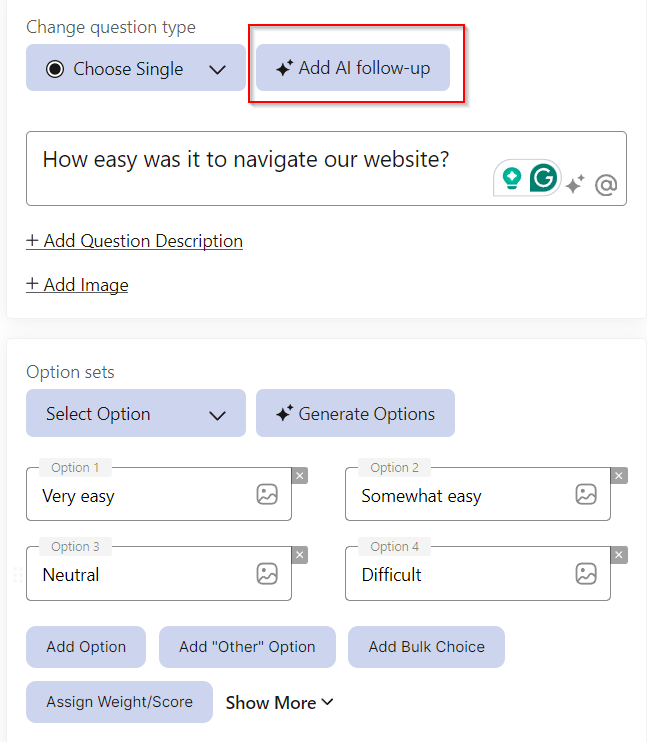- What are AI Follow-Up questions in surveys?
- What are the benefits of using AI Follow-Up questions in surveys?
- How do AI follow-up questions work in BlockSurvey?
- How to analyze Thematic and Sentiment insights?
- How to set up AI follow-up questions in BlockSurvey?
- How BlockSurvey handle AI Follow-Up Questions in different scenarios?
- What are the use cases for AI Follow-Up questions?
- Conclusion
Get insights.
Unlock value.
- 14-day free trial
- Set up in minutes
- No credit card required
How to design dynamic questionnaires using AI follow-up questions in surveys?
Imagine sending out a survey to collect valuable insights. However, the responses that came back were vague or incomplete. Static survey questions often leave gaps in understanding. When respondents provide unclear or incomplete answers, it becomes challenging to gather actionable insights. AI follow-up questions address this problem by making your surveys smarter, more personalized, and more interactive.
- What are AI Follow-Up questions in surveys?
- What are the benefits of using AI Follow-Up questions in surveys?
- How do AI follow-up questions work in BlockSurvey?
- How to analyze Thematic and Sentiment insights?
- How to set up AI follow-up questions in BlockSurvey?
- How BlockSurvey handle AI Follow-Up Questions in different scenarios?
- What are the use cases for AI Follow-Up questions?
- Conclusion
What are AI Follow-Up questions in surveys?
AI follow-up questions are dynamically generated based on a respondent's previous answers. Instead of relying solely on pre-defined questions, AI analyzes the context of responses and creates additional questions to clarify, elaborate, or dive deeper into the topic.
Example:
- Original Question: What did you like about the product?
- Initial Response: The design.
- AI Follow-Up: Could you share what aspects of the design stood out to you?
This process ensures that survey responses are richer and more detailed, helping you uncover insights that static questions might miss.
What are the benefits of using AI Follow-Up questions in surveys?
- Personalization: AI follow-ups tailor questions to each respondent's answers, making the survey experience more engaging and relevant.
- Improved Data Quality: By clarifying incomplete or vague answers, AI ensures your data is accurate and actionable.
- Save Time: Automating follow-up questions eliminates the need for manual intervention, streamlining survey analysis.
- Enhanced Respondent Experience: Respondents feel heard and understood, fostering trust and participation.
- Deeper Insights: Dive into nuanced perspectives and uncover insights that might go unnoticed.
How do AI follow-up questions work in BlockSurvey?
BlockSurvey integrates AI follow-up questions using the OARS questioning framework, a powerful methodology often used in motivational interviewing. OARS stands for:
- Open-ended questions – Encourage detailed responses.
- Affirmations – Validate the respondent's input.
- Reflective listening – Reiterate and clarify their responses.
- Summarizing – Summarize what has been shared to provide clarity and direction.
This approach helps BlockSurvey create meaningful, interactive follow-up questions that feel more like conversations than traditional surveys. Additional questioning frameworks like 5 Whys and PROBE will soon be available.
How to analyze Thematic and Sentiment insights?
BlockSurvey has advanced analytical capabilities for follow-up question responses. Once respondents submit their answers, you will soon be able to use the Regenerate button on the analytics screen to generate Thematic and Sentiment Analysis:
- Thematic Analysis identifies recurring topics or themes, providing a clearer understanding of respondent priorities.
- Sentiment Analysis evaluates emotional tones, categorizing responses as positive, neutral, or negative.
This feature offers survey creators an even more powerful way to uncover actionable insights from open-ended questions.
How to set up AI follow-up questions in BlockSurvey?
Steps for setting up AI follow-up questions in BlockSurvey is a seamless process:
Step 1
Choose your question type and input your initial question.
Step 2
Click on the Add AI Follow-Up button.

Step 3
In the AI Follow-Up Question popup, configure the following:
- Number of Follow-Up Questions: Add up to 5 AI-generated questions.
- Questioning Framework: Currently, BlockSurvey supports the OARS framework.
- AI Loading Text: Personalize the text displayed while the AI generates questions during the survey.
.png)
Step 4
Click “See How It Works” to view sample AI-generated questions.
.png)
Step 5
Close the popup and continue designing your survey. The AI follow-up settings are automatically saved.
Step 6
Publish the survey and submit a test response to ensure it works as expected before sharing it with your audience.
Note: AI Follow-Up Questions are available in the "One question at a time" view.
How BlockSurvey handle AI Follow-Up Questions in different scenarios?
In BlockSurvey, AI Follow-Up Questions are designed to enhance the survey experience by adapting to the respondent's answers. However, when respondents choose not to answer, provide short responses, or indicate a lack of interest in follow-up questions, the system intelligently adapts to ensure a smooth and respectful survey flow.
- Skipping the Initial Question: If a question with an AI Follow-Up is optional and the respondent skips it, no follow-up questions are generated. The survey simply moves to the next question, respecting the respondent's choice to skip.
- Encouraging Expanded Answers: For single-word or minimal responses, a gentle prompt on the survey screen like "Please expand on your response." This encourages respondents to provide more detailed answers while keeping the process engaging.
- Respecting Declined Follow-Ups: If a respondent does not wish to answer a follow-up question, for example, they can respond with something like "I am not interested in answering this question." The AI understands this response, skips generating additional follow-ups, and transitions to the next question in the survey. This ensures that respondents feel heard and respected while maintaining the flow of the survey.
By dynamically adapting to respondent inputs, BlockSurvey ensures that surveys remain conversational and user-friendly while gathering meaningful insights.
What are the use cases for AI Follow-Up questions?
AI follow-up questions are versatile and can be applied in various domains with sample questions:
- Product Feedback: Validate product ideas or features with potential users for development prioritization.
- Initial Question: Which feature do you think is most valuable?
- AI Follow-Up: Can you describe a situation where you would use this feature
- Education: Identify skill gaps and training needs among employees or students.
- Initial Question: Which area of your role do you struggle with the most?
- AI Follow-Up: What specific resources or tools would help you improve in this area?
- Personalized Career Counseling: Use AI follow-up questions to provide tailored questions on individual preferences and challenges.
- Initial Question: What are your top career aspirations?
- AI Follow-Up: What skills or experiences do you feel you're lacking to achieve this?
- Web3 Community surveys: In decentralized communities, understand members’ motivations and preferences for better engagement.
- Initial Question: What drew you to our DAO (Decentralized Autonomous Organization)?
- AI Follow-Up: What kind of governance model do you prefer, and why?
Conclusion
Don’t let incomplete or unclear responses limit your decision-making. Ready to Transform Your Surveys? With BlockSurvey's AI follow-up questions, make your surveys smarter, and gather richer, more meaningful insights, transforming your surveys into dynamic and conversational experiences.
How to design dynamic questionnaires using AI follow-up questions in surveys? FAQ
What are AI follow-up questions in surveys?
AI follow-up questions are dynamically generated based on a respondent’s previous answer. They aim to clarify, expand, or dive deeper into vague or brief responses, leading to richer insights.
How do AI follow-up questions improve survey quality?
They improve data accuracy, uncover hidden insights, and personalize the experience, making surveys feel like conversations rather than static forms.
Where can I use the AI follow-up feature in BlockSurvey?
AI follow-up questions are currently supported in the “One question at a time” view, ensuring a focused and conversational flow for each response.
Get insights.
Unlock value.
- 14-day free trial
- Set up in minutes
- No credit card required





